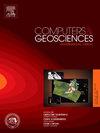Geoscience popularisation in Geoparks: A common workflow for digital outcrop modelling
IF 4.4
2区 地球科学
Q1 COMPUTER SCIENCE, INTERDISCIPLINARY APPLICATIONS
引用次数: 0
Abstract
Geodiversity has gained increasing attention, prompting geoscientists to advocate for its recognition to promote holistic nature conservation. UNESCO Global Geoparks (UGGps) have expanded globally, promoting geoheritage and contributing to geoconservation and sustainable tourism. In this framework, the IGCP 714 project, "3GEO – Geoclimbing & Geotrekking in Geoparks," launched in 2021, aims to use Geographical Information Technologies (GIT) – including GIS, remote sensing, Unmanned Aerial Vehicles (UAVs), and other geospatial tools - to enhance geoscience communication within UGGps. However, there is still a significant need for a repeatable, accessible, low-cost, and effective workflow to integrate these digital technologies into geoscience communication effectively. This study developed a workflow for creating Digital Outcrop Models (DOMs) of geosites and geodiversity sites used for recreational climbing and trekking. Using technologies such as UAVs and Smartphones equipped with LiDAR sensors, the workflow generates DOMs that can be integrated into web-GIS applications and Virtual Reality experiences, offering interactive educational content. Four examples are described, illustrating the implementation of the DOM workflow from the outcrop scale (La Pedriza Granitic Batholith, Spain, and Etna Volcano Lava Tube, Italy) to the terrane scale (Organ Pipes Columnar Jointing, Australia, and Baceno Tectonic Window, Italy). The workflow is designed to produce DOMs for public and student engagement, demonstrating their potential for broader educational and geoconservation applications. Moreover, the workflow aims to build capacity among Geopark practitioners and researchers by improving techniques for creating content on geoheritage features and enhancing geoscience communication. For this, the workflow is designed to be repeatable by employing common and relatively low-cost GIT tools. We discuss the need for investment in capability, software, and hardware to equip Geopark practitioners with the skills required to implement this workflow. By applying this workflow to create DOMs of geoheritage features, we demonstrate its potential to enhance the appreciation of geodiversity, support education and research, and promote sustainable geotourism within UGGps.

地质公园的地球科学普及:数字露头建模的通用工作流程
地质多样性受到越来越多的关注,促使地球科学家倡导对其的认识,以促进整体的自然保护。教科文组织世界地质公园在全球范围内扩展,促进地质遗产,为地质保护和可持续旅游做出贡献。在这个框架下,IGCP 714项目“3GEO -地理攀登”“地质公园徒步旅行”于2021年启动,旨在利用地理信息技术(GIT)——包括地理信息系统、遥感、无人机(uav)和其他地理空间工具——加强地质公园内的地球科学交流。然而,为了将这些数字技术有效地集成到地球科学通信中,仍然需要一个可重复、可访问、低成本和有效的工作流程。本研究开发了一个用于创建用于休闲登山和徒步旅行的地质遗址和地质多样性遗址的数字露头模型(dom)的工作流程。利用无人机和配备激光雷达传感器的智能手机等技术,工作流生成的dom可以集成到网络gis应用程序和虚拟现实体验中,提供交互式教育内容。本文描述了四个示例,说明了从露头尺度(西班牙的La Pedriza花岗岩基和意大利的Etna火山熔岩管)到地面尺度(澳大利亚的风琴管柱状节理和意大利的Baceno构造窗口)的DOM工作流的实现。该工作流程旨在为公众和学生提供dom,展示其在更广泛的教育和地理保护应用中的潜力。此外,该工作流程旨在通过改进创建地质遗产特征内容的技术和加强地球科学交流,建立地质公园从业人员和研究人员的能力。为此,工作流被设计为可重复的,通过使用通用的和相对低成本的GIT工具。我们讨论了在能力、软件和硬件方面进行投资的必要性,以使地质公园从业人员具备实施这一工作流程所需的技能。通过应用这一工作流程来创建地质遗产特征的dom,我们展示了它在提高对地质多样性的认识、支持教育和研究以及促进ugps内可持续地质旅游方面的潜力。
本文章由计算机程序翻译,如有差异,请以英文原文为准。
求助全文
约1分钟内获得全文
求助全文
来源期刊

Computers & Geosciences
地学-地球科学综合
CiteScore
9.30
自引率
6.80%
发文量
164
审稿时长
3.4 months
期刊介绍:
Computers & Geosciences publishes high impact, original research at the interface between Computer Sciences and Geosciences. Publications should apply modern computer science paradigms, whether computational or informatics-based, to address problems in the geosciences.
 求助内容:
求助内容: 应助结果提醒方式:
应助结果提醒方式:


